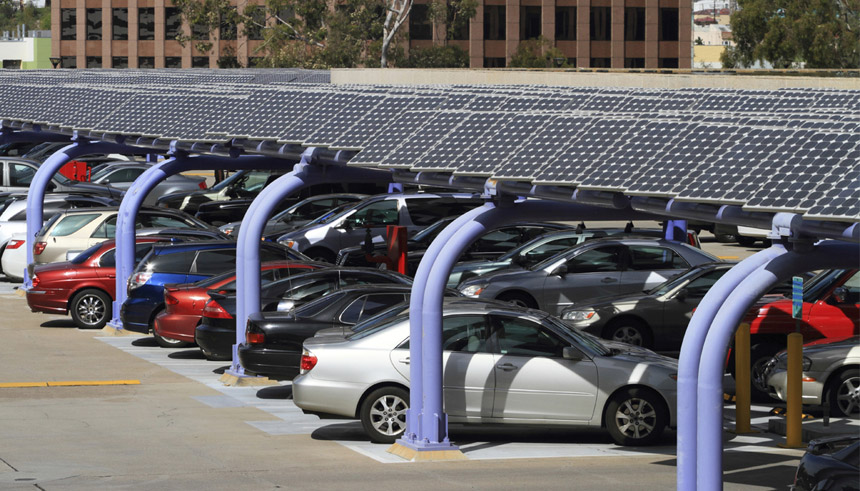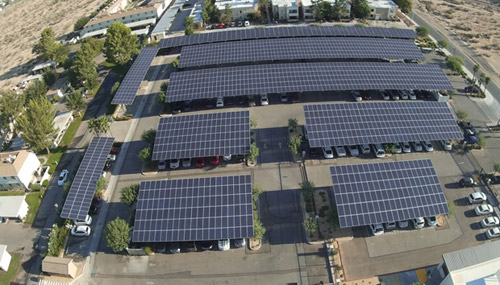East West Lifestyle
Ingenious Hack – Solar Parking Lots That Generate Power
By Ellen Chang

Real estate owners transforming parking lots into solar energy generators is a growing trend.
Office parking lots are no longer merely absorbing the sun, especially in the extremely hot summer months, emitting heat and being seen as an eyesore.
The use of solar canopies has grown in popularity across the United States as companies and municipalities are embracing the use of renewable energy to lower their energy costs and rely less on the power grid. Parking lots provide good locations for the canopies, since a study conducted by the U.S. Department of Energy’s National Renewable Energy Laboratory determined that only 26 percent of small buildings have rooftop areas suitable for a rooftop photovoltaic (PV) system.
The analysts conducted a study of 128 cities during a three-year period, and while the study only examined the potential of existing rooftops, the researchers found that creating solar canopies “over open spaces such as parking lots” has “immense potential,” said Robert Margolis, NREL senior energy analyst and co-author of the report.
The parking lots that are adjacent to industrial and commercial buildings could provide a good source of additional power, especially for cities that lack other existing solar panels on rooftops, or other renewable energies, such as wind. Airports were early adopters, since they already have immense parking lots, and companies with many employees, such as Ford Motor Co., have constructed solar canopies at their headquarters in Dearborn, Mich.
The use of solar was started on rooftops, but more companies and government agencies have started taking advantage of existing space, such as the addition of solar panels at the parking lots for the San Francisco International Airport in 2013. Even grocery stores such as the Whole Foods in Brooklyn, N.Y., have installed panels above their parking.
The benefit of solar panels on carports is that they can be constructed to increase power production in the afternoon, when the summer consumption of electricity is the greatest.
One parking space that is shielded with solar panels can produce an estimated 2 kilowatts of generating capacity and, in California, one parking space can generate 5 kilowatt hours of electricity each day, which translates to an electric vehicle driving a distance of 20 miles, wrote Donald Shoup in ACCESS Magazine. Shoup is a distinguished professor of urban planning in the University of California at Los Angeles’ Luskin School of Public Affairs and the editor of ACCESS Magazine, which reports on research at the University of California Transportation Center and the University of California Center on Economic Competitiveness.
Massive solar arrays have been erected. For example, the carport installation at Rutgers University in New Brunswick, N.J., occupies 28 acres, which means it can produce 8 megawatts of power, enough for 1,000 homes.
Why Solar Canopies are Gaining Popularity
The use of solar canopies is growing as costs have declined and now that pavement makes up 35 percent to 50 percent of the surface area of many cities. Half of that area contains streets and 40 percent is parking lots, which become extremely hot, said Haley Gilbert, a researcher at the Heat Island Group of Lawrence Berkeley National Laboratory.
The solar panels are placed on top of the carports, where there is direct sunlight and the cells are able to convert the sunlight into electricity. Utilizing more renewable energy means that power companies will have additional backup in cases of extreme weather, where blackouts and brownouts are not unheard of, or when the power grid is facing overcapacity because of extreme heat or usage.
The creation of solar carports is becoming widespread across the United States and has been implemented even in states such as New York, where the weather is not as favorable. Parking lots are becoming more attractive as an option and the adoption of renewable energy is rising, according to the U.S. Energy Information Administration. In a March report, the EIA said the total amount of renewables used will increase by 8.7 percent this year in the electric power segment. In 2017, that amount will rise by 6.5 percent. After an increase of 3 gigawatts (GW) in 2015, the use of utility-scale solar photovoltaic (PV) power capacity will rise by 9 (GW) this year. The states at the forefront of increasing the largest amount of utility-scale solar capacity additions are California, Georgia, Nevada, North Carolina and Texas.
While carport projects remain more expensive, the concept has caught on during the past three years with smaller canopies, said Cuong “Jacky” To, a vice president of emerging markets at East West Bank.
A new solar carport was recently built at the Rancho Cucamonga employee parking lot, increasing the production of renewable energy. The first phase will generate 55,000 kWh annually and eventually will have a total of 400 solar panels, generating 165,000 kWh, which could produce power for 25 households annually.

"The creation of solar carports is becoming widespread across the United States."
Better Aesthetics
These solar carports are particularly popular in California, where the days of sunshine greatly outnumber cloudy and rainy days. East West Bank has provided the financing for several projects in California, including a 900 kW carport solar project that was installed at the parking lots for three office buildings occupied by San Bernardino County government. This project is housed in a high desert community and taking advantage of the sizzling temperatures and continuous sunshine made sense.
California provides rebates for both consumers and commercial users through its California Solar Initiative for customers of Pacific Gas and Electric (PG&E), Southern California Edison (SCE) and San Diego Gas & Electric (SDG&E). One of the programs funds solar power for existing homes and existing or new commercial, agricultural and government buildings through solar photovoltaics and solar thermal generating technologies.
These projects also provide an opportunity for local residents to take advantage of employment opportunities.
“With equipment manufactured in China, the projects in San Bernardino County were built by a local contractor with local employees,” said To. “This project helped to create more jobs in an economically depressed area.”
Besides the benefits of increasing local employment, the county of San Bernardino will be able to reduce the carbon footprint and energy costs for the next 20 or more years, he said. The estimated annual carbon footprint offset at one San Bernardino County parking lots in Victorville is 724.35 tons, equivalent to the electricity used in 331 homes for one year, while another parking lot in the county, at Redlands, will have a carbon footprint offset of 200 tons.
Both of the projects will generate a large amount of wattage each year, adding capacity for local users. The Victorville facility will produce 1,005,163 kWh (kilowatt hours) while the Redlands facility can generate 336,159 kWh.
Future of Solar Carports
As the costs for manufacturing and constructing these solar canopies decrease, more companies will take advantage of the concept and will start installing them, To said.
“They are gaining in popularity,” he said. “Congress approved to extend the federal investment tax credit of 30 percent of the value of solar projects to 2019, so I foresee a lot more activity this year and in the next three to five years.”
Sign up for the Reach Further Newsletter
We’ll keep you in the know about the latest US-Asia business news and trends.
Suscríbase al boletín Reach Further
Lo mantendremos informado sobre las últimas noticias y tendencias comerciales entre Estados Unidos y China.

